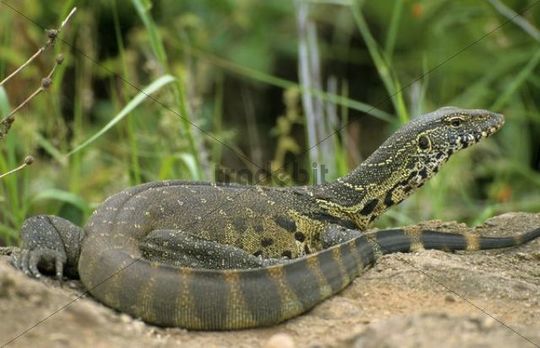Florida’s Dragon Problem
Huge monitor lizards have invaded the state, and the rest of the U.S. is one unlucky boatload away.
by Ed Yong

It’s also the largest lizard in Florida.
No one knows exactly when the monitor arrived in Florida, but it was first spotted in 1990. It was probably introduced as part of the pet trade. It then either escaped or was released by people who realized much too late that maybe a huge, intelligent, active, predatory lizard doesn’t make a great pet.
Once the monitors were free, events unfolded predictably. These lizards wander over large areas, grow quickly, breed at an early age, and lay up to 60 eggs in a single clutch—so their numbers quickly grew. They love water, and were drawn to the same waterfront properties that attract Florida home-owners. There are now three permanent breeding populations in the state, the largest of which includes more than 1,000 individuals.
To predict what the monitor lizard will do in the future, Stephanie Dowell from Fordham University decided to look at how it behaves in its native home. Together with her supervisor, self-confessed museum geek Evon Hekkala, Dowell sequenced the DNA of dozens of Nile monitors from all over Africa—both freshly caught individuals and those preserved in museum collections.
She found several surprises. A supposedly distinct species called the ornate monitor turned out to be the Nile monitor under a different name. So two lizards became one. But the canonical “Nile monitor” actually comprises three genetically distinct lineages from the west, north, and south of Africa. The western one should count as a distinct species: It separated from the others 7.7 million years ago and its genome differs by up to 9 percent, a far greater gulf than exists between us and chimpanzees. So one lizard became two again.
West Africa Nile monitor
https://en.wikipedia.org/wiki/West_Africa_Nile_monitor
The West Africa Nile monitor (Varanus stellatus) is a cryptic species of Polydaedalus monitor lizard from West Africa
The newly minted West African Nile monitor isn’t just genetically distinct, but also genetically narrow. Based on the similarities between different individuals, Dowell estimated that the lizard’s population crashed between 1,000 and 1,800 years ago. That coincides with the rapid expansion of the ancient Malian city of Djenné-Djenno—a major hub for trans-Saharan trade.Archaeological evidence confirmed that people were indeed catching and trading monitor lizards, probably for food. That’s why the lizard’s numbers plummeted.
Such exploitation continues today. Every year, around 500,000 Nile monitor skins are shipped around the world to be made into shoes, bags, and accessories. Another 10,000 live individuals are exported for the pet trade. And some of them have made their way to Florida.
When Dowell analyzed the DNA of 25 Florida monitors, caught by colleague Todd Campbell,
she found that all of them belong to the West African species. All are
descendants of lizards that had been captured somewhere between Liberia
and Cameroon and shipped across the Atlantic. This happened on at least
three separate occasions, giving rise to populations now living in Cape
Coral, West Palm Beach, and Homestead.
But the other species of Nile monitor is another matter. It can survive through the cold and frosty winters of southern Africa by hibernating. If it got into the U.S., Dowell’s simulations predict that it could make itself comfortable across the eastern and western seaboards, especially if the climate continues to warm.
“If, for example, we decided to crack down on the trade in West Africa, and the exploitation shifted to south Africa, that lineage could spread very quickly,” says Hekkala. “Its invasiveness is much greater. It is so pre-adapted to the North American climate that it could spread almost to Chicago, even without climate change.”
This scenario shows how important it is to stop the lizards from entering the country in the first place. “Once we figure out that a species is here, and there are multiple reports, it’s too late. We need to do a better job screening,” says Steve Johnson from the University of Florida. “We don’t do a good enough job as a state to regulate what’s coming in.”
He’s not wrong. Florida is the world’s number one hub for invasive reptiles and amphibians. It has several ports, a large population of potential pet-owners, and a warm, humid climate. Almost 140 alien species have made their home there, including cane toads, panther chameleons, Burmese pythons, giant tegu lizards, green anacondas, and tentacled snakes.
“Every bit of biological and ecological info we can get about a species in its native range takes us one step closer to coming up with a management strategy to control it in its introduced range,” says Johnson. “I don’t think we’ll ever eradicate Nile monitors from Florida but hopefully we can contain them.” And in the meantime, if you spot one, the Florida Fish and Wildlife Commission wants you to tell them about it on IveGot1.org (yes, really) or their IveGot1 app. And for pity’s sake, don’t try to capture one.
image:
Source: http://www.theatlantic.com/science/archive/2016/04/the-past-and-future-of-floridas-dragon-problem/478905/



No comments:
Post a Comment